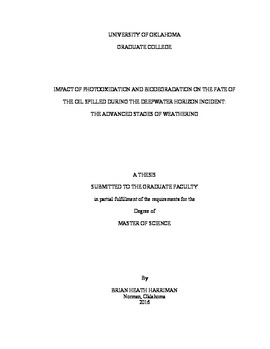| dc.description.abstract | The major biogeochemical forces influencing the environmental fate of spilled oil have been intensively investigated for many decades. The sinking and burying of spilled residual oil to form large mats that subsequently get broken up and washed onshore as sand patties has been well documented. While recognized as an integral part of the weathering process, the environmental fate and effects of sand patties and their component chemicals are not well known. We collected sand patties that were deposited in the swash zone on Gulf of Mexico beaches following the Deepwater Horizon oil spill. The exposure of sand patties to sunlight, seawater, and the indigenous microbial communities suggested that photooxidation and biodegradation might be important advanced weathering processes for these materials. When sand patties were exposed to simulated sunlight, a larger amount of dissolved organic matter (DOM) with greater UV absorption characteristics was photo-solubilized into seawater than the corresponding dark controls. This is consistent with the general ease of movement of seawater through the sand patties. High-resolution mass spectrometry as well as a variety of absorbance and fluorescence measurements revealed that the chemical nature of the DOM leached from the sand patties under dark and irradiated conditions was substantially different. In both cases, the DOM did not have a significant inhibitory influence on the endogenous rate of aerobic or anaerobic microbial respiratory processes. In addition, the DOM represented suitable electron donors to support at least short-term (3 d) aerobic microbial respiration activity. The water-soluble photooxidation products stimulated significantly more oxygen respiration (113 µM) than either the dark (78 µM) or the endogenous (38 µM) forms of DOM. The residual DOM analyzed at the end of the incubation was consistent with biodegradation as an explanation for the various changes in DOM quality and quantity. Thus, these results confirm that sand patties are not recalcitrant and their deposition on beaches does not represent an end point in oil weathering processes. Rather, sand patties undergo a gradual dissolution of DOM in both the dark and in the light, but photooxidation accelerates the production of water-soluble polar organic compounds that are relatively more amenable to aerobic biodegradation. As such, these processes represent previously unrecognized advanced weathering stages that are important in the ultimate transformation of spilled crude oil. | en_US |
